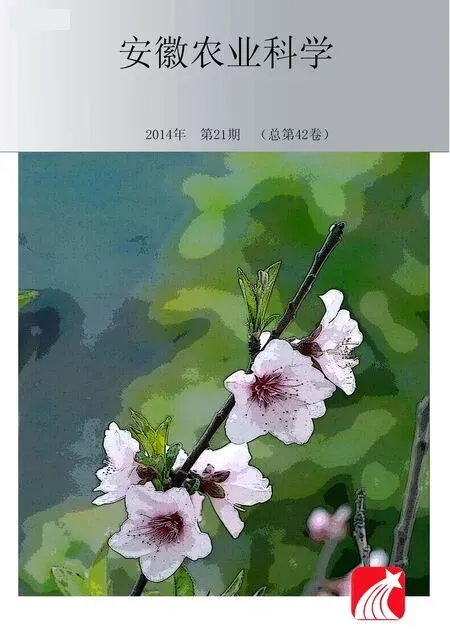象湖流域底泥重金属污染特征与生态风险分析
熊戬等
摘要[目的]了解城市湖泊底泥重金属的污染情况。[方法]以象湖流域为研究对象,利用微波消解-火焰原子吸收分光光度法、BCR连续提取法、ICPAES分别测定底泥中重金属的总量及各形态重金属的含量,并利用潜在生态危害法对象湖的潜在生态危害进行评价。[结果]象湖所测的潜在危害来源主要是Cd。[结论]该研究为城市湖泊生态系统退化的原因提供理论依据。
关键词底泥;重金属;污染特征;形态分析;RSP;潜在生态危害指数
中图分类号S181.3;X826文献标识码A文章编号0517-6611(2014)21-07151-04
Analysis on Heavy Metal Pollution Characteristics and Ecological Risk of Elephant Lake Water Body Sediment
XIONG Jian, LIU Xiaozhen et al(Key Lab of Poyang Lake Environment and Resource Utilization of Ministry of Education, School of Environment and Chemical Engineering, Nanchang University, Nanchang, Jiangxi 330047; School of Environment and Chemical Engineering, Nanchang Hangkong University, Nanchang, Jiangxi 330063)
Abstract[Objective] To study the pollution status of heavy metals in urban lake sediment. [Method] With Elephant Lake as study object, microwave digestion, flame atomic absorption spectrophotometry, BCR sequential extraction method and inductively coupled plasmaatomic emission spectrometry were used to determine the total and each species of heavy metal content. And the potential ecological risk was evaluated. [Result] The results showed that the content sequence of six kinds of heavy metals determined were Zn>Pb>Cu>Cr>As>Cd. The pollution of Cd was the most serious. The concentrations of Cu, Zn, Cd followed the trend escalation from deep to shallow. Only the ratio of secondary phase to primary phase (RSP) Cr in site xh3 was bigger than the three, the contamination level was serious. All the other sites belong to mild contamination. The potential ecological risk levels of all sites were strong except xh2 which level was medium. There sequence were xh4>xh4>xh3>xh1>xh2. Cd was the main pollution source of Elephant Lake from individual potential ecological risk coefficient. [Conclusion] The study can provide theoretical basis for urban lakes ecosystem degradation.
Key wordsSediment; Heavy metal; Pollution characteristics; Speciation analysis; RSP; Potential ecological risk index
城市湖泊是指位于大中城市城區或近郊的中小型湖泊,具有渔业、游览和给排水等服务功能,对于城市的可持续发展意义重大[1-2]。近年来随着城市人口的剧增,工业化水平的提升,城市湖泊的污染问题越来越严重。重金属由于其稳定性高、难降解、易生物积累等特点,对人类的健康存在重大威胁,成为当今世界重要的环境隐患[3-4]。而重金属污染是城市环境问题的一个重要方面,城市土壤重金属的研究多年来一直是国内外学者的研究热点[5-8]。城市湖泊要接纳大量包含大气降尘、街道灰尘和地表土壤等固体残渣的城市径流,这些固体残渣可能含有各种途径进来的重金属,通过沉淀、絮凝、吸附、络合、生物同化等作用,很大一部分重金属均会沉积到湖底[9-10]。通过研究城市湖泊底泥重金属的分布情况,能够综合了解城市湖泊受人类活动的影响情况,有利于了解城市湖泊生态系统退化的原因和城市湖泊对人类健康的潜在影响。笔者以南昌市象湖流域为研究对象,合理布点,对表层底泥重金属的浓度、象湖重金属垂直分布和表层底泥重金属形态特征进行研究,结合次生相与原生相比值法和潜在生态危害指数法对象湖的潜在生态危害进行评价,综合了解象湖流域重金属的污染情况以及对生态环境的影响。
1材料与方法
1.1采样区域概况象湖流域包括象湖和连接象湖和赣江的抚河故道(下简称抚河),象湖位于繁华的城中心地带,是典型的城内景观湖泊。象湖北部由抚河将其与赣江相连,湖水经抚河流入赣江。象湖作为城市湖泊,其污染来源主要是市政污水的排放。由于旧城区的废水排放标准低、水源减少以及淤积堵塞等原因,大量的市政污水和工业废水直接向象湖和抚河排放,导致水质严重恶化。
1.2样品采集与处理根据象湖的污染特点和功能区分布,对象湖5个采样点进行底泥样的采集,抚河的采样点确定主要依据沿岸的4个主要排污口确定,具体的采样点分布如图1所示。从南至北各采样点的编号依次为
3结论
(1)象湖中Cu、Zn、Cr、As的表层底泥重金属浓度在一级土壤浓度限值以下,Pb的浓度处于一级限值与二级限值之间,Cd仅有xh1和xh2在三级限值以下,其他点的浓度均在三级限值以内,各点重金属的平均浓度Zn>Pb>Cu>Cr>As>Cd;抚河各点重金属污染均非常严重。
(2)象湖5种元素仅Pb的次生相与原生相的比值RSP值小于1,其余均略大于1,为轻度污染。排污口xh3的Cr和Cd RSP分别为3.43和2.23,屬于重度污染和中度污染,其他各采样点均有重金属元素RSP>1且最大值<2,属于轻度污染;5个采样点的潜在危害程度xh3>xh2>xh4>xh1>xh5。 潜在危害指数法的评价结果与RSP法评价结果差异较大,象湖的5个采样点中,除了西边采样点(xh2)潜在生态危害程度为中等外,其余潜在生态危害程度均是强,5个点的潜在生态危害顺序为xh4>xh5>xh3>xh1>xh2,Cd是象湖重金属的主要潜在危害因素。
参考文献
[1] 彭晶倩,李琳,曹雯,等.城市湖泊水环境安全评价研究[J].环境保护科学,2010,36(5):62-64.
[2] 温周瑞,王丛丹,李文华,等.武汉城市湖泊水质及水体富营养化现状评价[J].水生态学杂志,2013,34(5):62-64.
[3] YUAN H,SHEN J,LIU E,et al.Assessment of nutrients and heavy metals enrichment in surface sediments from Taihu Lake,a eutrophic shallow lake in China[J].Environmental Geochemistry and Health,2011,33(1):67-81.
[4] 毛欣,陈旭,李长安,等.大冶市城市湖泊表层水体中重金属的分布特征及其来源[J].安全与环境工程,2013,20(5):33-37,84.
[5] LU X,WANG L,LEI K,et al.Contamination assessment of copper,lead,zinc,manganese and nickel in street dust of Baoji,NW China[J].Journal of Hazardous Materials,2009,161(2):1058-1062.
[6] LU Y,GONG Z,ZHANG G,et al.Concentrations and chemical speciations of Cu,Zn,Pb and Cr of urban soils in Nanjing,China[J].Geoderma,2003,115(1):101-111.
[7] BANERJEE A D K.Heavy metal levels and solid phase speciation in street dusts of Delhi,India[J].Environmental Pollution,2003,123(1):95-105.
[8] LEE P K,YU Y H,YUN S T,et al.Metal contamination and solid phase partitioning of metals in urban roadside sediments[J].Chemosphere,2005,60(5):672-689.
[9] FRIESE K,SCHMIDT G,DE LENA J C,et al.Anthropogenic influence on the degradation of an urban lakeThe Pampulha reservoir in Belo Horizonte,Minas Gerais,Brazil[J].LimnologicaEcology and Management of Inland Waters,2010,40(2):114-125.
[10] HU X,WANG C,ZOU L.Characteristics of heavy metals and Pb isotopic signatures in sediment cores collected from typical urban shallow lakes in Nanjing,China[J].Journal of Environmental Management,2011,92(3):742-748.
[11] PARDO R,HELENA B A,CAZURRO C,et al.Application of twoand threeway principal component analysis to the interpretation of chemical fractionation results obtained by the use of the BCR procedure[J].Analytica Chimica Acta,2004,523(1):125-132.
[12] 邱敏娴,胡恭任,于瑞莲,等.泉州湾洛阳江河口潮滩表层沉积物中重金属赋存形态分析[J].环境化学,2013,32(2):212-218.
[13] 王海,王春霞,王子健.太湖表层沉积物中重金属的形态分析[J].环境化学,2002,21(5):430-435.
[14] 王鸣宇,张雷,秦延文,等.湘江表层沉积物重金属的赋存形态及环境影响因子分析[J].环境科学学报,2011,31(11):2447-2458.
[15] 刘峰,胡继伟,吴迪,等.基于形态学分析红枫湖沉积物中重金属的分布特征及污染评价[J].环境化学,2011,30(2):440-446.
[16] 赵胜男,李畅游,史小红,等.乌梁素海沉积物重金属生物活性及环境污染评估[J].生态环境学报,2013 ,23(3):481-489.
[17] 刘志杰,李培英,张晓龙,等.黄河三角洲滨海湿地表层沉积物重金属区域分布及生态风险评价[J].环境科学,2012,33(4):1182-1187.
[18] HAKANSON L.An ecological risk index for aquatic pollution control.A sedimentological approach[J].Water Research,1980,14(8):975-1001.
[19] 何纪力,徐光炎.江西省土壤环境背景值研究[M].北京:中国环境科学出版社,2006:35-45.

